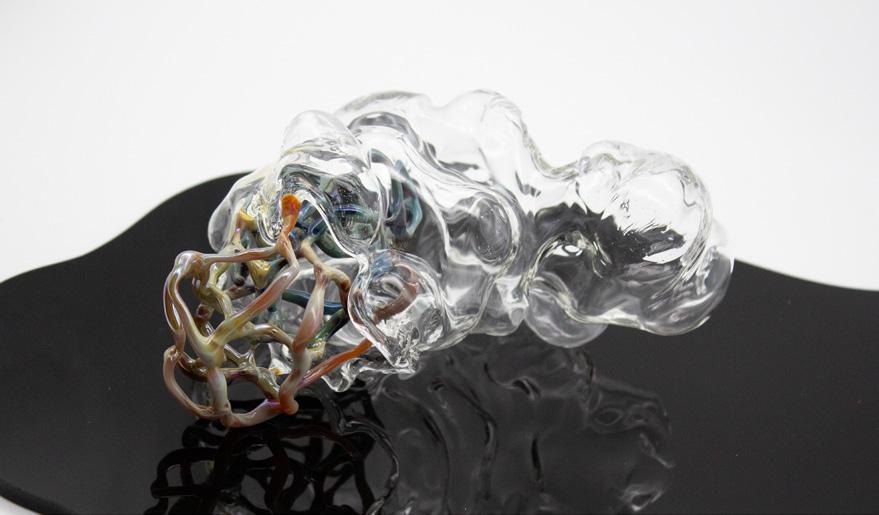
14 minute read
S H U Y I C A O
by Para Site
Intimacy of Strangers I, 2023
Handblown borosilicate glass
20.3 × 12.7 × 12.7 cm
Courtesy of the artist
Intimacy of Strangers II, 2023
Handblown borosilicate glass
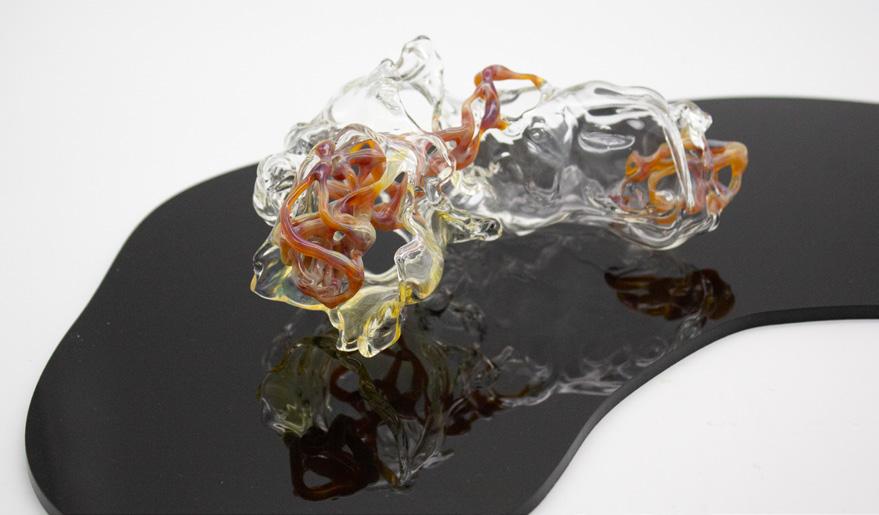
20.3 × 12.7 × 12.7 cm
Courtesy of the artist
Intimacy of Strangers III, 2023
Handblown borosilicate glass
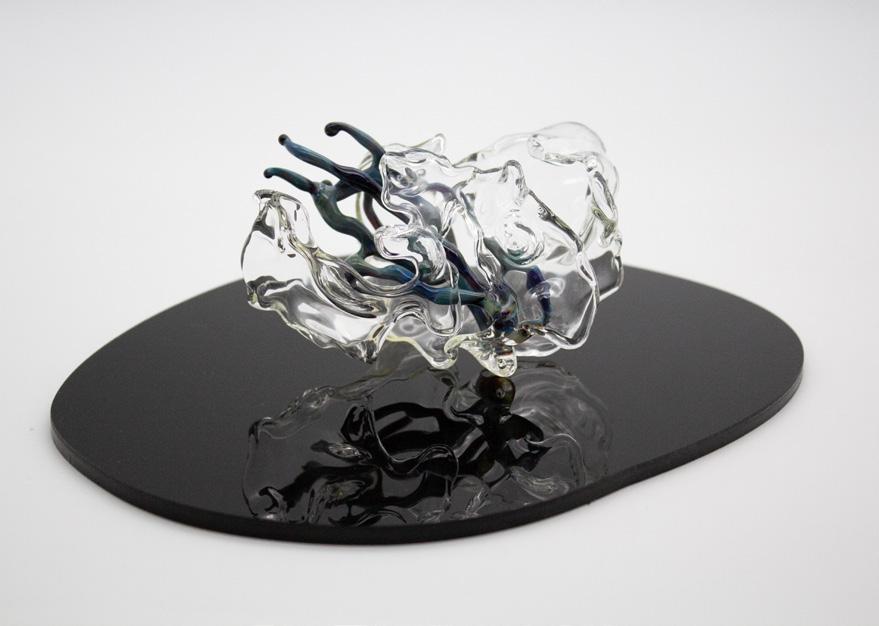
15.2 × 12.7 × 12.7 cm
Courtesy of the artist pabulite (primordial bliss), 2023 Glazed stoneware
By integrating natural and synthetic materials and idiosyncratic forms, the three handblown borosilicate glass works under the series Intimacy of Strangers (2023) highlight the central role of symbiosis in the evolution of early life forms. The objects evoke an uncanny sense of familiarity and estrangement, haunting the viewer with their past incarnations tracing their own biological and mineral origin, while encoding the clues for future evolution. Seemingly floating on a circular plinth in robin egg blue, the three works are caressed by natural sunlight by day, and the metallic moonbeam from Leelee Chan’s neighbouring Circuit (New Moon) (2021) by night. The iridescent reflections and refractions symbolise the boundless possibilities in endosymbiosis. Contrary to the conventional understanding that evolution takes place in a progressive, forward-moving, linear approach, some of its most significant events result from the togetherness of di erent organisms across domains. Eukaryotic cells in animals, plants, fungi, and protists arise from the components of other organisms. For instance, organelles like mitochondria and chloroplast were once free-living prokaryotes but were later engulfed by other cells. Rather than being eradicated by the host, they continue to live symbiotically inside it. Evolving together over time they now function as a single organism, and one cannot exist without the other. In this sense, all life forms, including human beings, are walking miracles of an intimate cellular encounter that turns into an amorous entanglement— once strangers, now neighbours.
78.7 × 96.5 × 10.2 cm
Individual dimensions:
(L) 38.1 × 33 × 3.81 cm
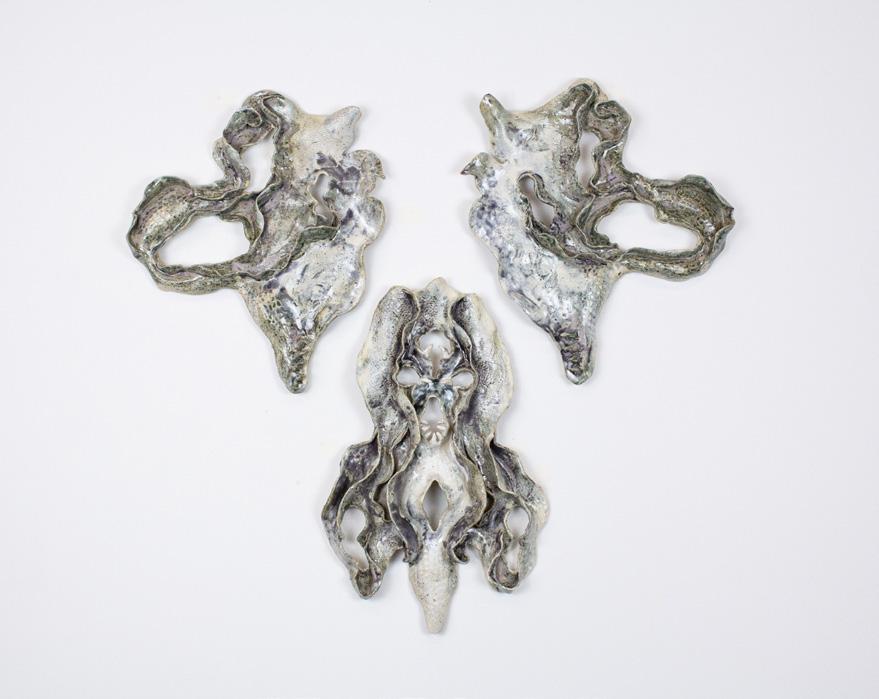
(M) 38.1 × 35.6 × 3.81 cm
(R) 29.2 × 44.5 × 5 cm
Courtesy of the artist as they folded in and breached out (tentacular), 2023
Installed as a wall totem in the exhibition space, pabulite (primordial bliss) (2023) consists of three glazed stonewares. Appearing as shedded skins or eroded landscapes, they serve as an emblem that confronts the viewer with its unimaginable ancestral traces, while reflecting upon the radical metamorphism in an ever-changing environment. The term pabulite was proposed by a recent paleontological study to describe the discovery of hybrid fossilised remains of a crustacean, a belemnite, and a vertebrate, caught in the digestive process from the Early Jurassic Posidonia Shale. Composed of the Latin term 'pabulum' for food and the Greek term 'lithos' for stone, pabulite refers to incomplete organismal remains that can show traces of the organisms' predation; put di erently, it represents the living and intense entanglement in petrified form. The artist employs a meticulous technique in handling clay to depict indefinable body parts that are seemingly the decay of various life forms in metallic green, gold, silver, lilac, and midnight blue hues, including fangs, skins, scales, and gastrointestinal tracts. By visualising the dissection and deconstruction of such conglomerates, the work encapsulates a mini-ecology that presents the violent yet intimate predatorand-prey relationship and interspecies interactions through the consumption and excretion of other life forms that are broken down into materials.
Glazed stoneware
43 × 25 × 28 cm
Courtesy of the artist as they folded in and breached out (sprout), 2023
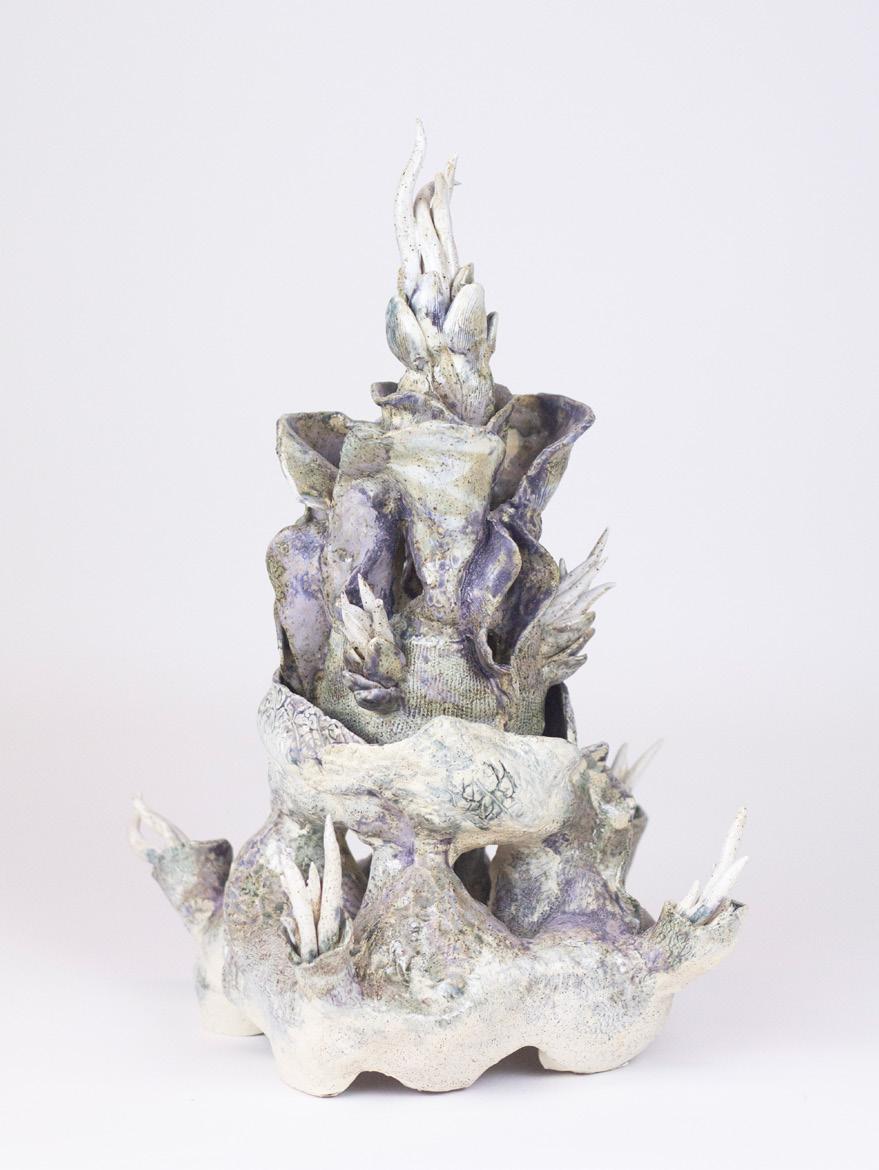
Glazed stoneware
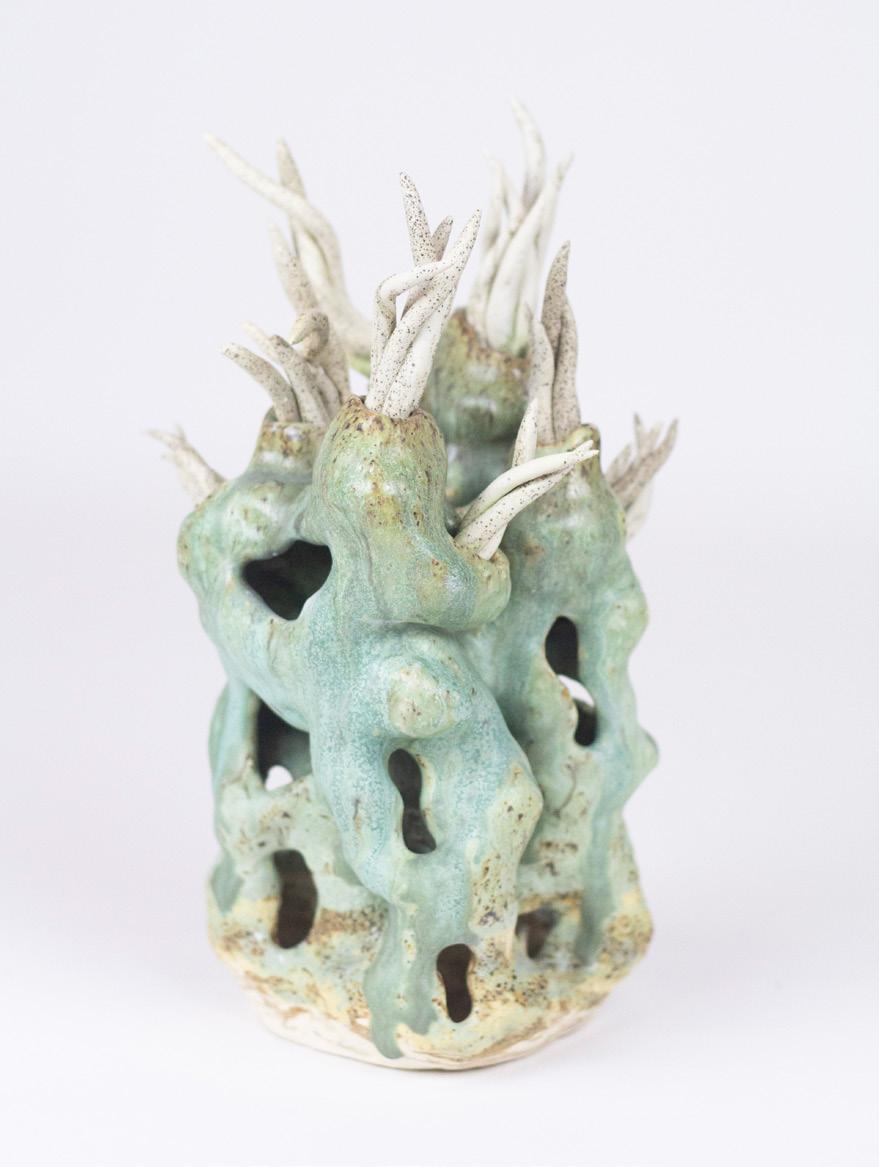
30 × 18 × 18 cm
Courtesy of the artist as they folded in and breached out (bursting), 2023
Glazed stoneware
47 × 30.5 × 30.5 cm
Courtesy of the artist
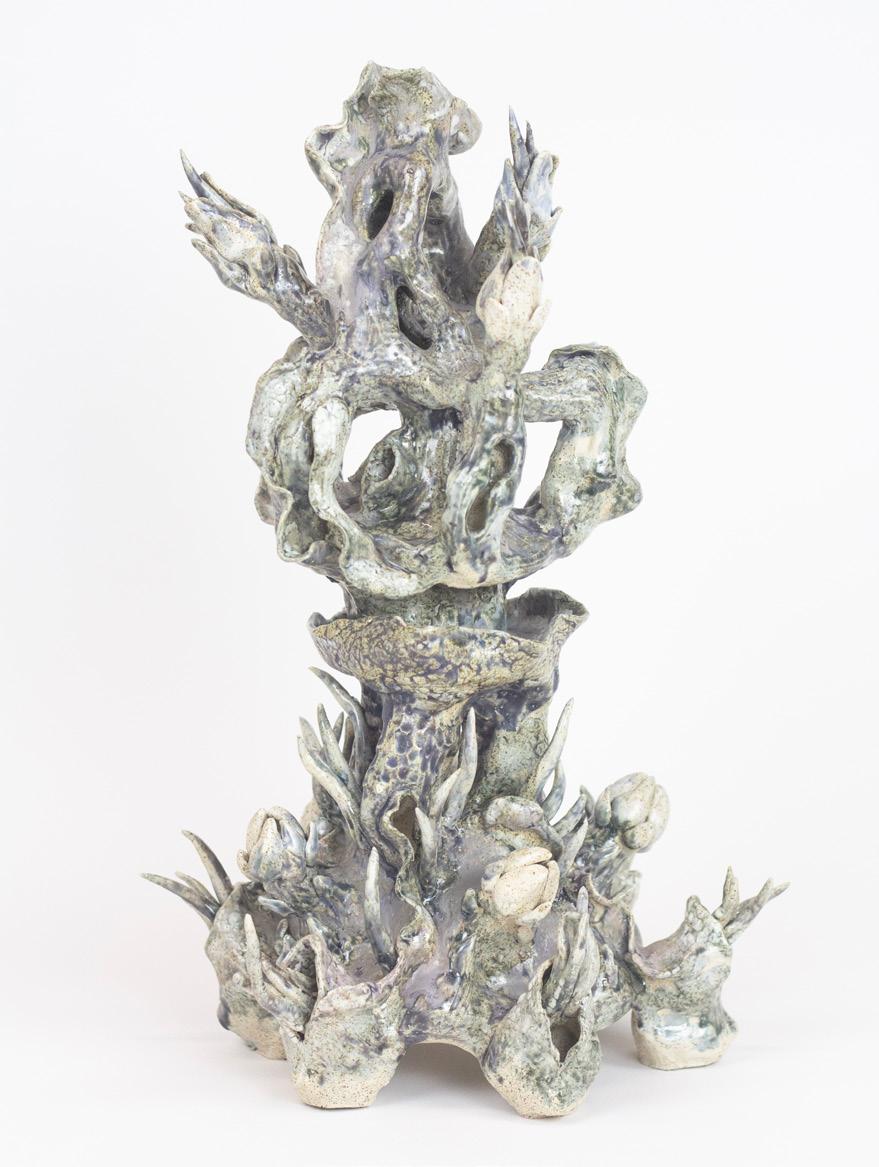
Presented on metal plinths in lemongrass hues, the three glazed stoneware sculptures under the series as they folded in and breached out (2022–23) traverse classifications of animal, vegetal, fungal, and mineral. Drawing from the environmental philosophy of deep ecology, which promotes the inherent worth of all living beings regardless of their instrumental utility to human needs, the artist highlights the existence of organisms that are abjected by an anthropocentric worldview. O shore fragments like barnacles, algae, and marine invertebrates, as well as indeterminate vestiges of scales, tendrils, gills, limbs explore manifold evolutionary pathways that arise from an erratic climate. The multi-layered and lively sculptures with twisting tentacles and protruding sprouts invite the viewer to ponder further the symbiotic, mutualistic, parasitic, and cancerous relationship between these elusive organisms, particularly how they undergo unexpected developments under conditions of extreme weather, rising sea levels, melting polar ice caps, and declining biodiversity. As Leelee Chan's Ooliths (Yellow zinc) (2022) slowly encroach upon the plinths, the viewer can also envision how these bath-stone barnacles will interact and converse with Cao's uncanny organisms, leading to a potentially bizarre and mutated growth. Meanwhile, the folding and breaching on these glazed stonewares, along with the environments they inhabit, such as the hollow metallic structures, symbolise a highly permeable and boundless biosphere that defies any binary structures, nurturing queer kinships across myriad networked life forms.
Said N’ba N’ga, who lived in certain muddy shallows, among the roots of some protoconifers, 2021 Aqua resin, acrylic paint
78.7 × 58.5 × 10.2 cm Courtesy of the artist
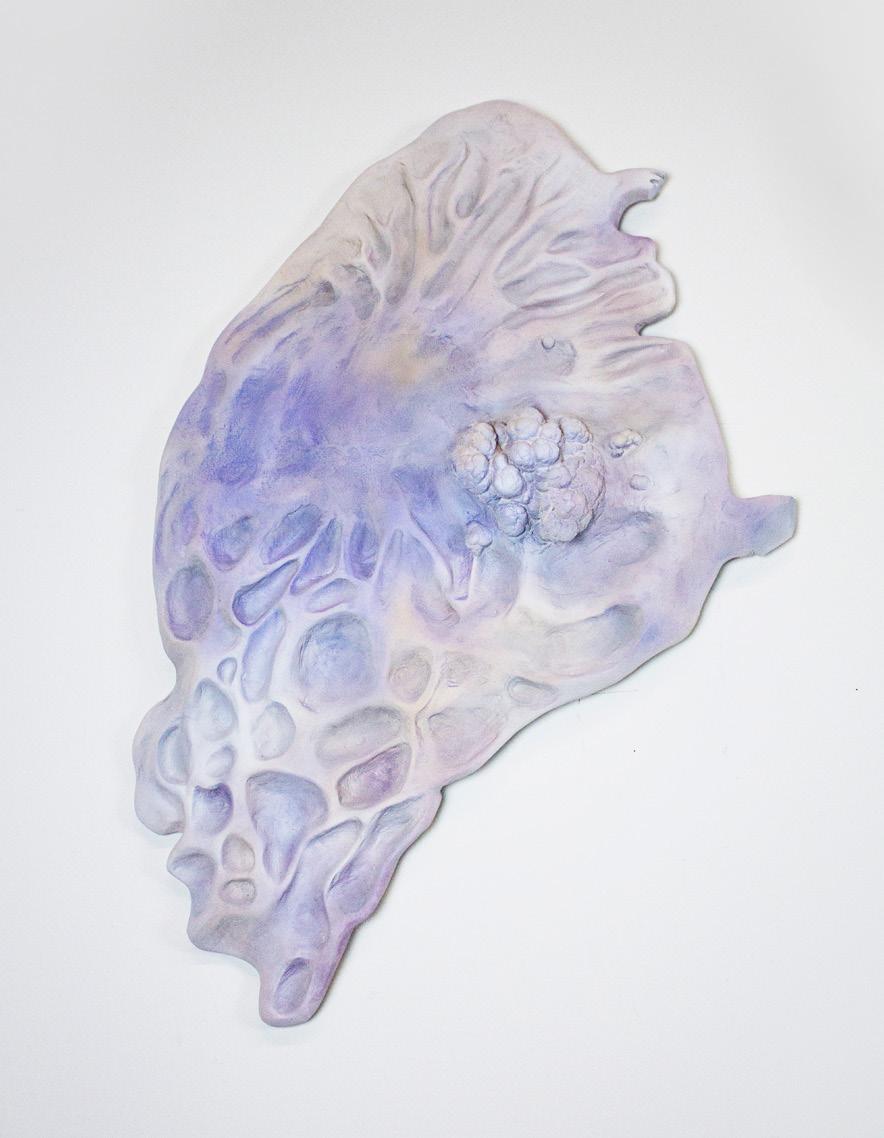
Said N’ba N’ga, whose eyes as round and inexpressive as stones, meet her oblong eyes, 2021
Aqua resin, acrylic paint, glass
71.1 × 38.1 × 10.2 cm
Courtesy of the artist
Inspired by Italo Calvino's 'The Aquatic Uncle', this body of work consists of four aqua resin wall pieces in vibrant violet hues, which speculates the evolving transmutation between aquatic and terrestrial life forms, drawn from the paleontological evidence of the first vertebrates who leave the sea to arrive on land in the Carboniferous period. The short story revolves around the protagonist Qfwfq, whose family mostly dwells on land by adapting fins into paws and becoming reptilian in the process. As the only member who still lives in the sea as a fresh-water Coelacanthus, their greatuncle N'ba N'ga is perceived as the black sheep of the family
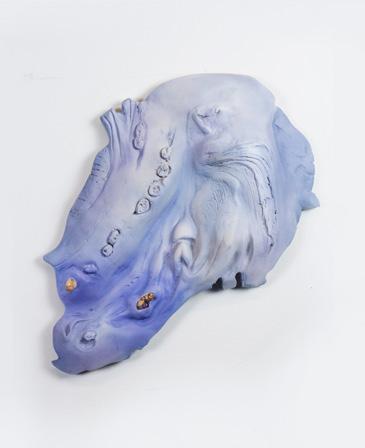
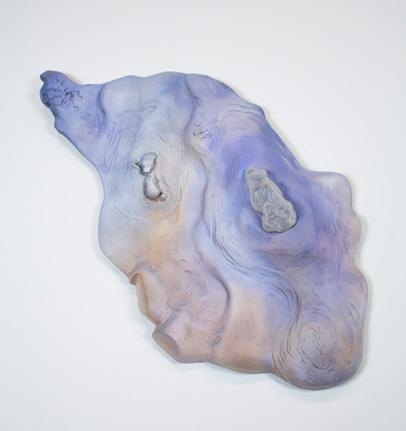
Said N’ba N’ga, as they surfaced and cleft the waters, 2021
Aqua resin, acrylic paint, glass
58.4 × 35.6 × 7.6 cm
Courtesy of the artist who refuses to come ashore like 'civilised' people. With life on the land symbolising the manifesto of the promised future and the one in the deep sea as unwanted primitive regression, the narrative highlights the problematic obsession with rationality and progress in modernist thinking in connection with environmental and queer debates. The artist translates such unsettling ecological poetics into forms that allude to residues of interspecies metamorphosis. The intriguing marks, patterns, and formations on the sculptures resemble the fossilised remains of coelacanths such as the scales, spiky fans on the
Said N’ba N’ga, the land were going to disappear just as they had cropped up, 2021 Aqua resin, acrylic paint
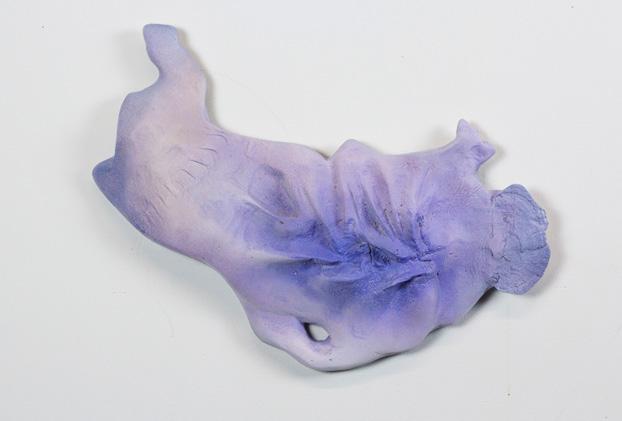
48.3 × 25.4 × 7.6 cm, Courtesy of the artist fins, and crescent-shaped tail. They map out the ancestral traces of land vertebrates and hauntingly remind the viewers of their once 'non-modern' past. Each sculpture also represents key confrontational and realising moments in the short fiction. One of them is when Qfwfq's fiancée Lll encounters N'ba N'ga for the first time by the lagoon, marking the return of the repressed where she begins an awakening journey to reconnect with and later submerge into negated history. Similarly, being entranced by the four enigmatic sculptures, the audience may embark on a familial odyssey, tracing the complex formation and expansion of their own lineage and kinship.
Leelee Chan
Born in 1984 in Hong Kong; lives and works in Hong Kong
Leelee Chan makes enigmatic sculptures that incorporate urban debris, ancient artefacts, natural materials, and industrial products, generating visual paradoxes in which these objects move seamlessly between past, present, and future. Reflecting the shifting urban fabric in her immediate surroundings in Hong Kong, Chan's sculptures undergo an elaborate transformation through tactile experimentation with materials and processes. She pushes the limits of her objects' physicality and expands the possibilities of abstraction. In 2020, Chan was the recipient of the ninth BMW Art Journey. She has participated in exhibitions including at Tai Kwun Contemporary, Hong Kong (2021, 2018); Para Site, Hong Kong (2021); Skulpturen Park Köln, Cologne (2020); X Museum, Beijing (2020); and UCCA Dune, Beidaihe (2019). Chan's work can be found in the permanent collections of M+, Hong Kong; Skulpturen Park Köln, Cologne; UBS Art Collection, Hong Kong; and Kadist Art Foundation, Paris and San Francisco. Chan received her MFA in painting from the Rhode Island School of Design and her BFA from the School of Art Institute of Chicago.

L E E L E E C H A N
Seaglass Equilibrium, 2019

Metal plate, concrete, polystyrene foams, pigment, seashell and found glass plates
101 × 91 × 45 cm
Courtesy of the artist and Capsule Shanghai, Shanghai
Seaglass Equilibrium (2019) consists of an aquamarine base with concrete sculptures scattered over the surface, with two pieces of translucent L-shaped glass plates a ixed on top that were found by the artist at the dumpster across from her studio. Created as a site-specific installation for UCCA Dune in Qinhuangdao, the freestanding sculpture is recontextualised for this exhibition to engage in a visceral dialogue with Para Site's space, where passages were created for visitors to cross a threshold into the newly connected spaces. Placed between the two passages, the work resembles a pendulum that exerts pressure to withstand a duality of forces. Between the glass components are two seashells balancing on a pair of small concrete parts cast from plastic egg package containers. The juxtaposition of pliable and unyielding materials in sculpture making visualises the artist’s search for consonance in dissonance, while the installation method that relies on gravity represents the transient nature of equilibrium in ecology. With its oceanic hues, coarse textures, and barnacle-shaped components, the sculpture also captures how barnacles live in shallow and tidal waters amid prolonged seawater erosion and marine pollution by drawing nuanced connections between plastic household products and arthropods. As barnacles tend to attach to hard substrates such as the bottom of ships, they may slow down the vessels and cause them to be less energy e icient, leading to significant rise in costs for human trading activities—thus unfortunately relegating them to pests by humans. However, filtering organisms such as barnacles play an essential role in the food chain. They cleanse the marine ecosystem by consuming plankton and dissolved detritus suspended in the ocean, yet their diet also makes them vulnerable to pollution such as microplastics. Ironically, the barnacle-shaped sculptures here are made from casts of the creatures’ worst enemy. Probing the permeable circulation of urban debris and artificial products, and highlighting barnacles' vital position in marine ecosystems, the sculpture deconstructs the boundary between human and marine organisms and questions the anthropocentric understanding of the value of non-human life forms in capitalist economies.
Ooliths (Yellow zinc) (2022) is a sitespecific intervention that further explores the artist’s interest in barnacles and arthropods alike. An extension of Chan's Seaglass Equilibrium (2019) in the exhibition, this set of sculptures is made in bath stones rather than concrete, highlighting the impermeable feature of the barnacles' calcite shells that help with adapting against water loss. As if fueled by voltaic forces, these sculptures with magnetic facets concentrate on the electricity box in the exhibition space. The sculptures also drift to the minimalist and ethereal plinths that showcase the stoneware works by the other artist Shuyi Cao, which resemble fragments and residues of the ocean such as algae and marine invertebrates. The work reflects the attachment nature of barnacles and how such organisms form various networks and systems by absorbing and tracing energy flows. The scattered barnacle components also echo the black dots in the exhibition graphics designed by Fibi Kung, where the clusters and constellations of equivocal life forms manifest modes of ecological thinking.
Ooliths (Yellow zinc), 2022
Bath stone, zinc-plated hex nuts, magnets, resin
Dimensions variable
Courtesy of the artist and Capsule Shanghai, Shanghai
Circuit (New Moon), 2021
Found plastic pallet, copper plate gifted by Filipino D’Aloise, bronze powder, stainless steel mirror, metal hardware, gold sheen obsidian 94 × 45.5 × 16 cm
Private Collection, Shanghai Courtesy of the artist and Capsule Shanghai, Shanghai

In Circuit (New Moon) (2021), Chan continues the survey into ancient and modern materials informed by conversations with craftsmen, innovators, and scientists on her BMW Art Journey in 2020. The wall-mounted sculpture has a frame comprised of plastic pallets the artist collected around Hong Kong, while at its centre is embedded a circular copper plate gifted to the artist during her BMW research trip by Filipino D’Aloise, one of three remaining coppersmiths in the mediaeval Italian town of Agnone. In addition to juxtaposing the historic practicality of copper with the modern abuse of plastic, and stripping both materials of their functions, the work serves as an extended metaphor for the e ects moon phases have on marine life. Not only does the moon’s gravitational pull generate tides, but its revolution around the Earth also guides marine life in feeding, communicating, mating, and spawning. Ocean organisms synchronise themselves with the lunar cycle, falling into patterns and rhythms that vary with the brightness of moonlight. The work is displayed near Shuyi Cao’s handblown borosilicate glass sculptures, which represent organisms in each of the three biological domains. Hovering over the primordial life forms, the copper ‘new’ moon appears to be activating an alternative trajectory for evolution.
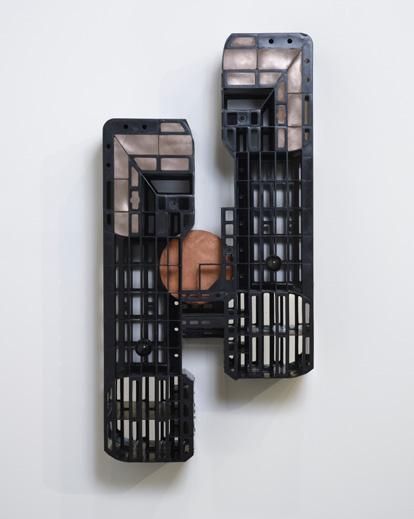
Lithic Current (detail), 2023
Found shipping pallets, found bumper polystyrene foams, powder-coated metal sheet, plastic flowers, Jesmonite, stainless steel hardware, epoxy 159 × 100 × 100 cm
Commissioned by Para Site for this exhibition Courtesy of the artist, Capsule Shanghai, Shanghai, and Klemm's, Berlin
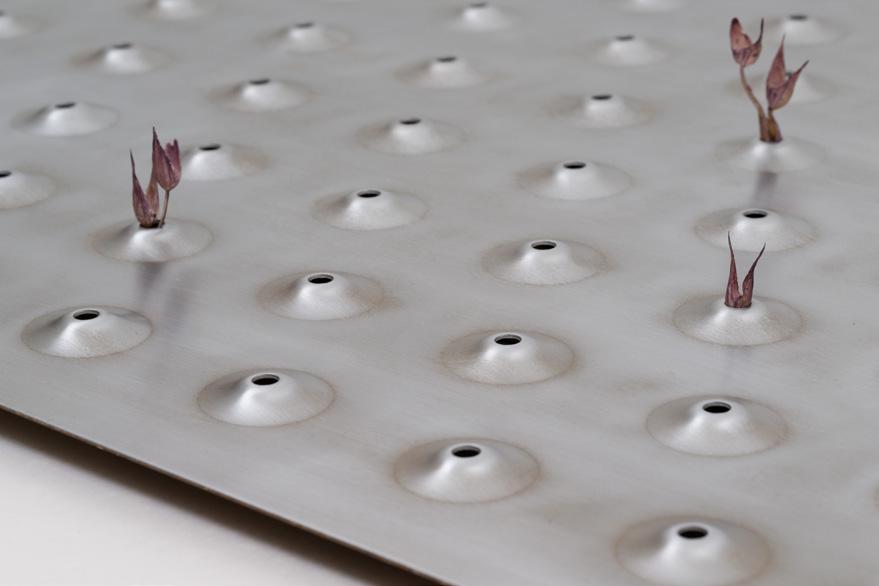
Leelee Chan's commissioned free-standing sculpture Lithic Current (2023) o ers the viewer a distinctive perspective in understanding the in-flux nature of materials vis-a-vis the multi-faceted concept of time. The title may suggest a forward movement of nature marked by geological force; nevertheless, the work consists of erratic, serendipitous materials such as found shipping pallets, car bumper packaging, an anti-slip perforated metal sheet, and artificial plants, presenting a contemporary depiction of neolithic ecology that undermines distinctions between the natural and the nonnatural. The car bumper packaging with its arch shape, for instance, is reimagined as long fossilised bones; the malleable plastic pallet in rigid form resembles polished and porous stones; while the anti-slip metal perforated sheet is the soil where artificial plants bloom from the debossed holes. In addition, influenced by her parents who are owners of a Chinese antiques shop along Hollywood Road in Hong Kong, the work echoes the attributes of scholar's rocks, which are ornate natural rock formations that are prized for their aesthetic properties. Evoking microcosms of vast geological forces that inspire meditative thoughts, the sculpture encourages the audience to contemplate the flows of matter by understanding the artist's time-sensitive creative process. Chan’s laborious and repetitive coating and sculpting on the found bumper polystyrene foam with epoxy softens the material’s mechanical form, just as how water and wind erode and create openings in the rock, marking residues of deep time. By employing industrial materials from the present and casting them into a rock formation devoid of hundreds and thousands of years of geological process, the paradoxical work presents a gathering of materials in movement that invites the audience to witness the process of its ongoing formation.
Moth, 2023
Found shipping pallets, petrified wood, stainless steel hardware, epoxy, pigment 113 × 12 × 28 cm
Commissioned by Para Site for this exhibition Courtesy of the artist, Capsule Shanghai, Shanghai, and Klemm's, Berlin
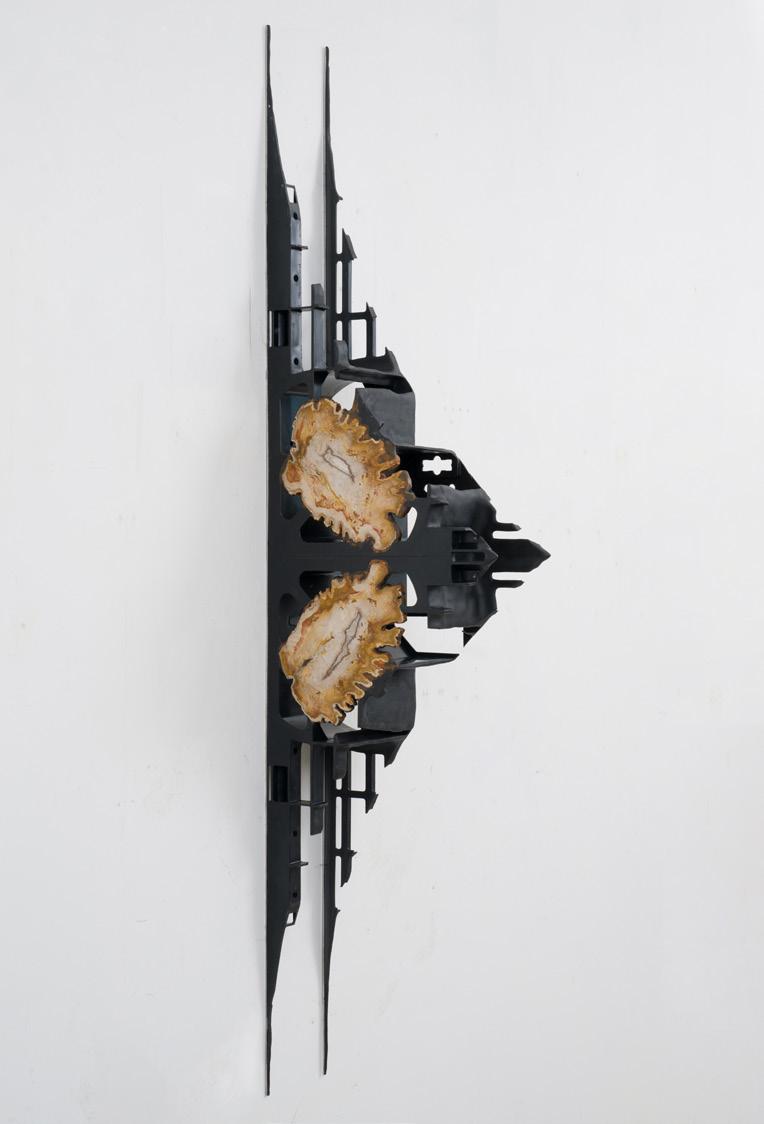
Moth (2023) is a commissioned wall sculpture that morphs the artist's signature found plastic pallets with petrified wood into an ambiguous hybrid. Plastic pallets are manufactured from mass production and require prolonged decomposition, while the formation of petrified wood takes at least hundreds of thousands of years and multiple stages of mineralisation. Despite the divergence of their qualities, Chan views them as materials rather than objects or artefacts, unlocking their metamorphic potential for further making, growth, and transformation. By compressing temporality, interweaving historical narratives, and fusing the attributes of the materials, the artist enables the sculpture to evolve into an enigmatic creature that evokes the power of life and death. Inspired by moths' behavioural patterns, the work is installed near the beams to mimic how they tend to settle in unexpected corners. Moths embody the messengers for the departed, its presence a grim reminder that despite life’s many powers, death is an inescapable fate. When faced with mortality, there is no di erence between humans and other organisms; all that is left is once aggregates of matter.
Moths' uncanniness not only connects with cessation but also somehow they are symbolically inferior to the butterfly. Our biological classification involves comparison and contrast between organisms; when it comes to moths, many conventionally comprehend them as nocturnal insects that lack the clubbed antennae of butterflies. In other words, a moth's existence depends on its lack, exposing how humans heavily rely on othering to separate and construct the concepts of non-human beings and encompassing nature. The obscurity of Chan's sculpture, from its polished dark body to the embedded fossilised wings, resonates with the organism's queer (non-) existence. Vitalised by the ancient energy of petrified wood and the worldliness of found plastic pallets, the biomorphic form is on the verge of fluttering its wings towards reality just as a moth to the flame, flinging itself into a state where one traverses the ideological fixation on nature and leaps into the fissures of signification and subjectivity.
About the Curator
Cusson Cheng is a curator and art critic from Hong Kong. As assistant curator at Para Site he has curated ‘Fanatic Heart’ (2022) and worked on exhibitions including ‘Minding the G(r)a(s)p’ (2022), ‘Noble Rot’ (2021–2022), ‘Liquid Ground’ (2021), and ‘Curtain’ (2021). He was also one of the delegates for the 2019 Para Site International Conference & Workshops for Emerging Professionals. His curatorial credits outside institutions include ‘Retrograde’ (2022) at Galerie du Monde, Hong Kong. Cheng also serves as art editor at the Hong Kong-based leading Chinese-language art periodical Art and Piece, for which he has interviewed internationally renowned artists, including Marina Abramović, Oliver Beer, Genieve Figgis, Nicolas Party, Patricia Piccinini, and Pipilotti Rist. He has contributed his writing and expertise in leading tours, including at Whitestone Gallery, Hong Kong (2022); and Perrotin, Hong Kong (2021). Cheng received his BA with Honours in comparative literature, sociology, and Buddhist studies from the University of Hong Kong.
Para Site is Hong Kong’s leading contemporary art centre and one of the oldest and most active independent art institutions in Asia. It produces exhibitions, publications, discursive, and educational projects aimed at forging a critical understanding of local and international phenomena in art and society.
Strange Strangers
30.06 13.08.2023
Curator
Cusson Cheng
Project Coordinator
Helen Leung
Artists
Shuyi Cao, Leelee Chan
Graphic Design
Fibi Kung
Fragrance Sponsor
Alongside artist fees to all participating artists, Para Site is offering medical and dental subsidies for Hong Kong artists in the exhibition.
Special thanks to all the artists, as well as
Silvia Bonsiepe
Capsule Shanghai, Shanghai
Chan Hon Lam
Chan Lai Ki June
Kelvin Cheng
Chung Yen Chak
Deng Peiyuan
Hongzheng Han
Klemm's, Berlin
Sebastian Klemm
Kobe Ko
Marlene Lieu
Ethan Joshua Luk
Alec Milea
Ngai Long Hin
Enrico Polato
Marta Santi
Tang Hoi Ying
Wang Xindi
Dickson Wong
Wong Ka Ho
Wu Lok Hang
Zhiyi Zhou
PARA SITE TEAM
Billy Tang
Executive Director and Curator
Kelly Ma
Deputy Director
Celia Ho
Curator
Cusson Cheng
Assistant Curator
Doris Poon
Exhibition Manager
Jason Chen
Communications Manager
Juliana Chan
Development Manager
Holly Leung
Gallery Manager
Jackson Kwong
Project Coordinator
Harold Chan
Project Coordinator
Helen Leung
Project Coordinator
Para Site Board
Alan Lau Ka Ming Chair
Mimi Chun Mei-Lor Vice Chair
Antony Dapiran Treasurer
Sara Wong Chi Hang Secretary
Nick Adamus
Shane Akeroyd
Bonnie Chan Woo Tak Chi
Dr. Yeewan Koon
Alan Y Lo
Fed Tan
Young Kar Fai Samson
Global Council
Shane Akeroyd
Mimi Brown & Alp Ercil
Jehan Chu
Mimi Chun & Chris Gradel
Samantha & Jamie Goodman
M Art Foundation
Benedicta M Badia Nordenstahl
Inna Rodchenko-Highfield & Tucker Highfield
Dina Shin
Vanessa Ying Xu
Virginia Yee
Ethan Yip
Founding Friends
Stephen Cheng
COLLECTIVE Studio
David Zwirner Gallery
Alan Lau
Wendy Lee
Edouard & Lorraine Malingue
Schoeni Projects
Sunpride Foundation
Friends
A Pipeline
Almine Rech Gallery
Nick & Cordula Adamus-Voegtle
Christine & James Boyle
Rachel Catanach & David Boyce
Jane DeBevoise
Yan Du
Jacobo Garcia Gil
Clarisse & Sean Garman
Jina Lee & Jae Won Chang
Lisson Gallery
Alan Lo
Kai-Yin Lo
Ingrid Lok & Tim Li
Magician Space
Elaine W. Ng
Justin Ng
Arjuna Rajasingham
Stefan Rihs
Fabio Rossi
Roman Ruan & Freda Yang
ShanghART
Angelle Siyang-Le
Tabula Rasa Gallery
Bonnie & Darrin Woo
Dayea Yeon
Kelly Yip
Contact
www.para-site.art
Para Site
22/F & 10B, Wing Wah Industrial Building
677 King’s Road, Quarry Bay
Hong Kong
+852 2517 4620 info@para-site.art
Wednesday to Sunday, 12:00 – 19:00 hrs
Closed on Monday, Tuesday, and Public Holidays
Facebook/Instagram: @parasite.hk
Wechat: parasitehongkong


